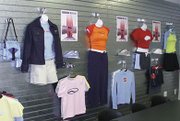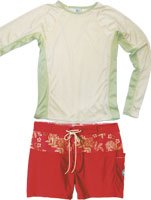Boardsports: Where the Girls Are
Apparel makers tap into young women’s growing interest in action sports
Girls are still in the minority when it comes to participating in boardsports, including surfing, skateboarding and snowboarding, but the number of girls taking up those sports is substantial.
Board-Trac, an Orange County, Calif.-based market research studies group that surveys the lifestyles and purchasing habits of action sports markets, found that girls make up approximately 16 percent of 880,000 active surfers between the ages of 12 and 19, approximately 9 percent of 7.8 million skateboarders in the same age range, and about 28 percent of 2.5 million snowboarders in their early to late teens.
Those are numbers compelling enough to make men’s action sportswear manufacturers take notice. Such surf giants as Quiksilver, Billabong and Rusty have successfuly built junior labels for these customers. Skate brands including Split have also entered the junior arena.
Even retailers have taken notice with the opening of freestanding stores that cater to young, active women, notably Quiksilver’s Roxy store at South Coast Plaza in Costa Mesa, Calif., and Jack’s Girls in Huntington Beach, Calif., the latter of which was spun off from the surf apparel mainstay Jack’s Surf Shops.
“The whole market has exploded as an enormous opportunity with tremendous buying power,” said Todd Dalhausser, director of Vans’ apparel division, which is the latest to join active girls’ markets. The company, which has had a girls’ shoe line for several years, plans to debut a 16-piece juniors collection at its retail stores in April.
Some manufacturers see women’s interest in boardsports as an opportunity to provide them with fashionable, yet functional, apparel.
Santa Clara, Calif.-based WaterGirl launched on the scene three years ago with a line of surf apparel and swimwear designed with a realistic fit. The company used women surfers as fit models and tested the line in action.
Other companies take a broader approach by downplaying the focus on boardsports and highlighting their labels’ fashion features.
“We are doing really well with our fashionable, feminine styles,” said Orange County-based Split Girl designer Jessica Langley, who said the company plans to debut its preppy-inspired Fall 2002 collection at the upcoming Action Sports Retailer Trade Expo (ASR) in Long Beach, Calif. “We still hit on sporty themes like preppy, denim and fleece. But our focus is really not on being a boardsport brand.”
Still, Split Girl and other girls’ sportswear makers encourage their customers and potential customers to participate in boardsports through the Girls Learn to Ride program, which hosts clinics for women to learn how to surf, skateboard or snowboard.
Girls Learn to Ride founder Mark Sperling started his Laguna Beach, Calif.-based events company three years ago to create a relaxed atmosphere for women between the ages of 5 and 65 to learn boardsports.
“Nowadays a lot of girls want to participate in the sports as much as the guys do,” Sperling said. “Companies that were previously devoting a lot of time to men are starting to see strong role models for women in action sports, like the snowboarder Tara Diakides and the surfer Malia Jones, who also happens to be a high-fashion model. Companies see that this is a more viable market.”
This year, Sperling is planning 40 clinics that will take place in various locations throughout the United States.
The point where fashion meets function for girls’ boardsports apparel has also given rise to alternative brands, including Deesse, a Los Angeles-based girls’ action sportswear brand founded in 1999.
Olary Yim, president of Deesse, said that before her company launched, surf and fashion were an unusual mix. “Our company was born during the fusion of boardsports and fashion, so we really try to keep our niche specific to girls who enjoy boardsports,” she said.
Yim, who estimates Deesse’s sales will reach $2.2 million for 2002, said the Feb. 2–4 run of ASR at the Long Beach Convention Center will be a good indication of the strength of the girls’ boardsports apparel market and the continuing interest in new labels.
“We’ll have to see what the response is at ASR for retailers and what they’re willing to put out towards the smaller alternative brands,” she said. “A show like this will be a clear indication of the changes in attitudes toward these trends and will serve as an early forecast for what retail spending will be like for the coming year.” —Claudia Figueroa























